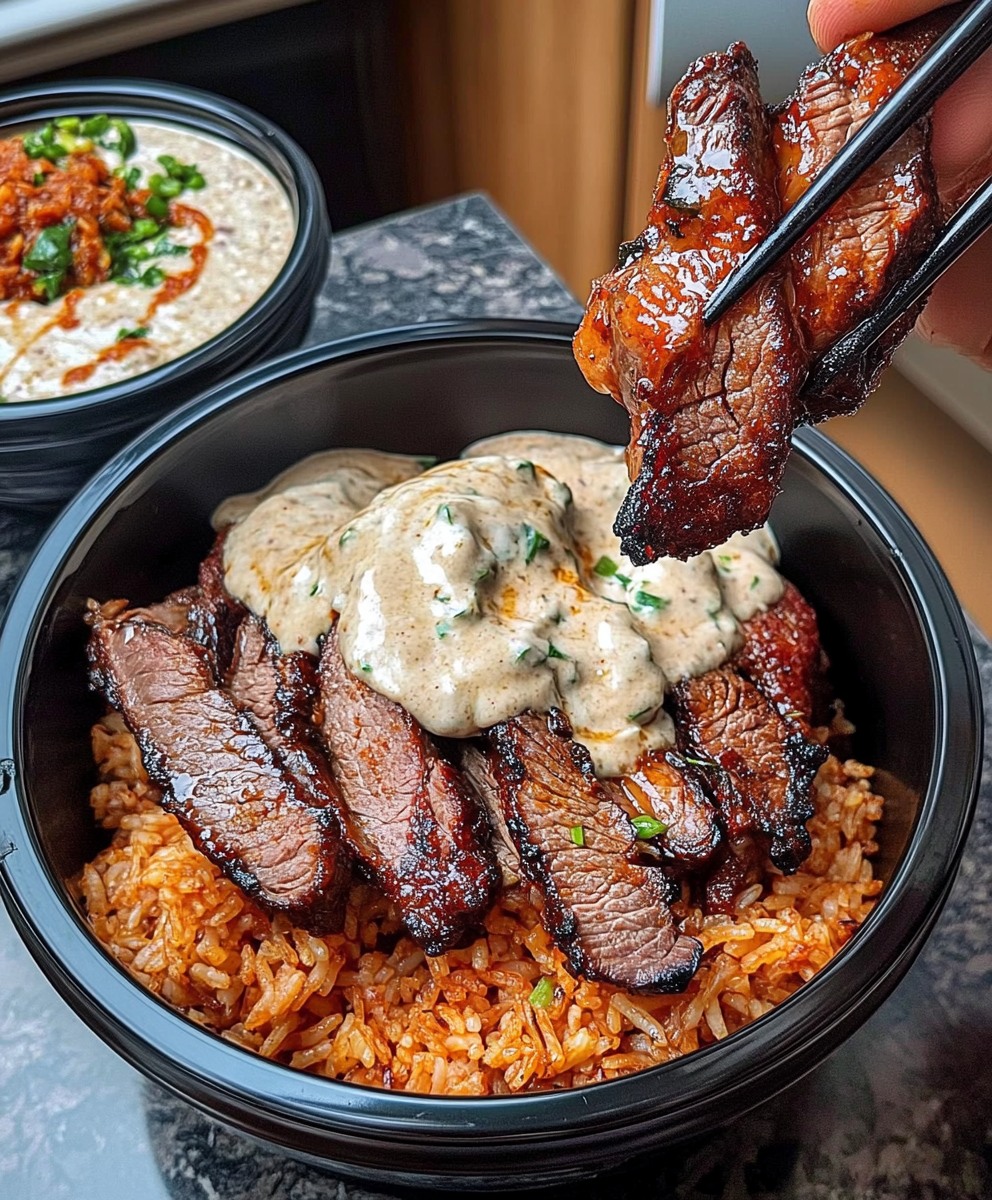Introduction
Korean BBQ, or gogi-gui, is more than just food—it’s a culinary experience deeply rooted in tradition. This method of grilling marinated meat has captured the hearts of food enthusiasts worldwide, making dining both a social and flavorful event.
In today’s fast-paced world, bowl meals have surged in popularity, offering a convenient yet nutritious dining option. They seamlessly blend variety with balanced nutrition, often combining proteins, grains, and vegetables in one simple dish. This trend reflects modern dietary preferences for meals that are both satisfying and wholesome.
The uniqueness of this Korean BBQ Steak Bowl lies in its perfect harmony of flavors and textures. The marinated steak, grilled to perfection, pairs exquisitely with the creamy sauce, offering a delightful contrast. Each bowl is customizable, encouraging individual creativity while staying true to its authentic roots. This dish not only delivers an unforgettable taste but also provides a visual feast, presenting vibrant colors and fresh ingredients.
Ingredients and Their Importance
When preparing a dish as vibrant and flavorful as Korean BBQ Steak Bowls, understanding the role of each ingredient is crucial. Let’s embark on a culinary journey to explore the heart of this recipe.
The Creamy Sauce
The magic of the creamy sauce lies in its perfect balance of heat and creaminess. Made with mayonnaise and sour cream, it serves as a cool contrast to the spiciness of the grilled steak. Sriracha adds an irresistible kick, while salt and pepper fine-tune the flavors. Feel free to adapt the heat levels to your liking – after all, cooking is all about personal touch!
The sauce doesn’t just enhance the taste; it elevates the entire experience of enjoying the bowl. When drizzled over, it harmonizes the flavors, making each bite as delightful as the last.
Creating the Ultimate Bowl
The assembly of the bowl is where culinary art meets personal creativity. Start by leveling the base with cooked rice, selecting from white, brown, or jasmine according to your preference. The neutral flavor of rice serves as a perfect canvas for the rich and savory grilled steak.
Next, add the hero of the dish – the marinated and grilled steak cubes. Their charred exterior and juicy interior bring a tantalizing texture and flavor. Finish with a generous drizzle of the creamy sauce, ensuring every corner gets a taste.
To add flair to your creation, consider topping the bowls with kimchi, pickled carrots, cucumber slices, green onions, or toasted sesame seeds. Not only do these toppings add color and extra flavor, but they also provide a delightful crunch, enriching the overall dining experience.
The Steak
- Types of Steak Suitable for Korean BBQ
- The Role of Marinade
Rice and Its Variants
Choosing the right rice is pivotal in crafting the perfect Korean BBQ Steak Bowl. Whether you opt for white, brown, or jasmine rice, each variety offers a unique texture and flavor profile. White rice provides a soft and neutral base, while brown rice adds a nutty flavor and extra fiber. For a more aromatic choice, jasmine rice is an excellent option. Using a rice cooker can ensure that your rice is cooked perfectly every time, taking the guesswork out of preparation.
- Macronutrient Breakdown Understanding the macronutrient breakdown of your Korean BBQ Steak Bowl helps in managing dietary goals. Typically, these bowls provide a balanced ratio of proteins from the steak, carbohydrates from the rice, and healthy fats from the creamy sauce. Adjusting the quantity of steak or sauce can alter the protein or fat content to better suit your nutritional requirements.
- Caloric Content The caloric content of your bowl will depend on the specific ingredients and portion sizes used. For those mindful of their calorie intake, this meal can easily be adjusted. Choose leaner cuts of steak, reduce the amount of sauce, or opt for a smaller rice portion to make it a lighter option.
- Healthy Tweaks Portion control is key to maintaining a healthy diet. Customize your bowl by controlling the amount of each ingredient. Adding more vegetables like shredded purple cabbage, thinly sliced mango, or roasted broccoli can increase the volume without significantly boosting calories. Healthy tweaks can make your bowl even more nutritious. Swap regular mayonnaise with a low-fat version for the creamy sauce, or increase the protein by adding a 6-minute soft-cooked egg. Details like these can transform your meal while adhering to your health goals.
FAQs
- What are some good side dishes to serve with these bowls? Pair these Korean BBQ Steak Bowls with traditional Korean sides like kimchi, which adds a tangy and spicy counterpart to the rich and savory steak. Pickled vegetables or seaweed salad also make delightful companions, offering a refreshing crispness to your meal.
- Is there a vegan or vegetarian alternative for the steak? Absolutely! Substitute the beef steak with marinated tofu or tempeh to create a satisfying plant-based alternative. Opt for the same marinade used for the steak and let the tofu or tempeh soak for at least 30 minutes. Grill or pan-fry until crispy on the edges for a deliciously different texture.
- How long can I store the leftovers in the refrigerator? You can store any leftovers in an airtight container in the refrigerator for up to 3 days. When reheating, consider doing so gently over a medium heat stovetop or in the microwave to maintain the texture and moisture of the ingredients.

